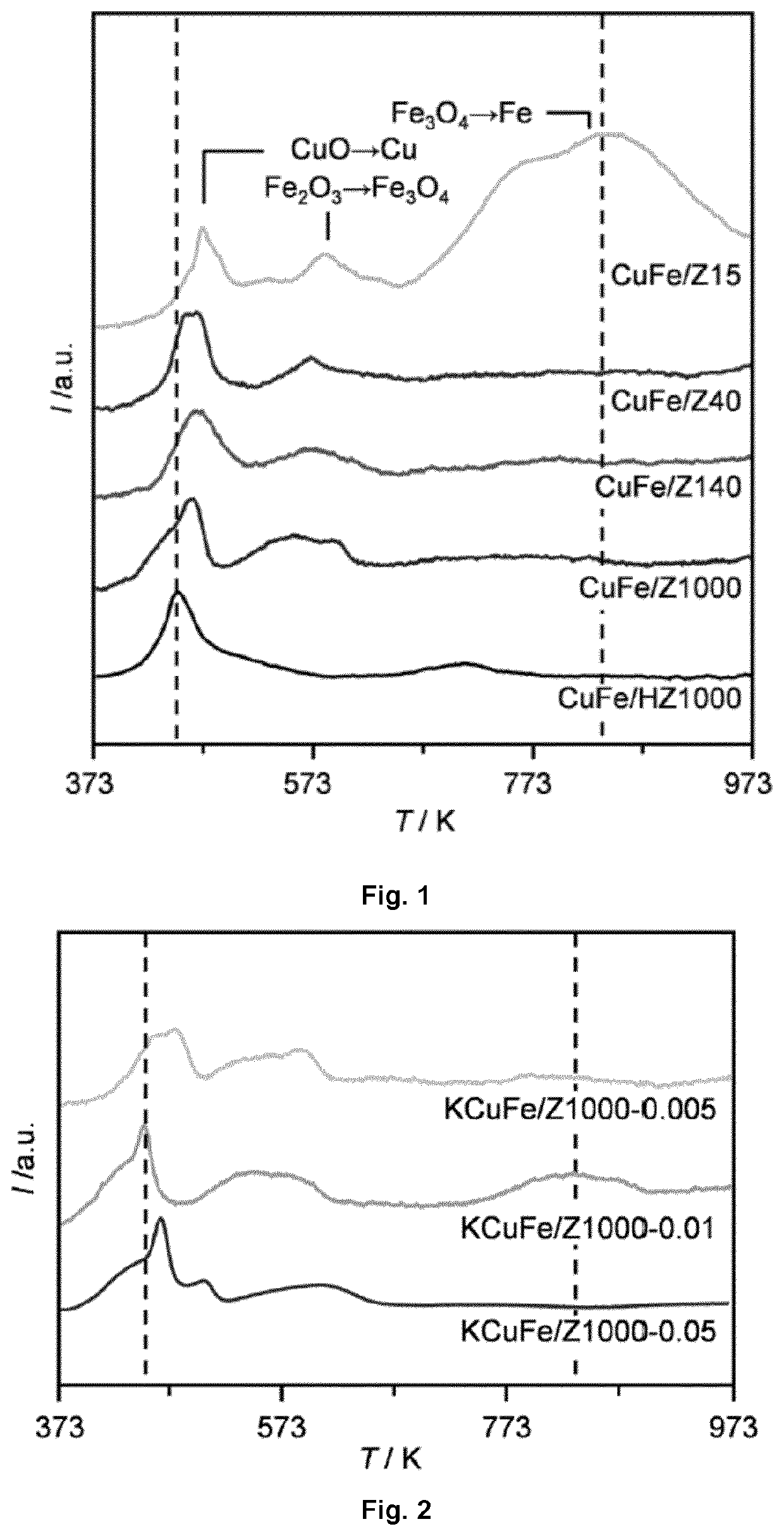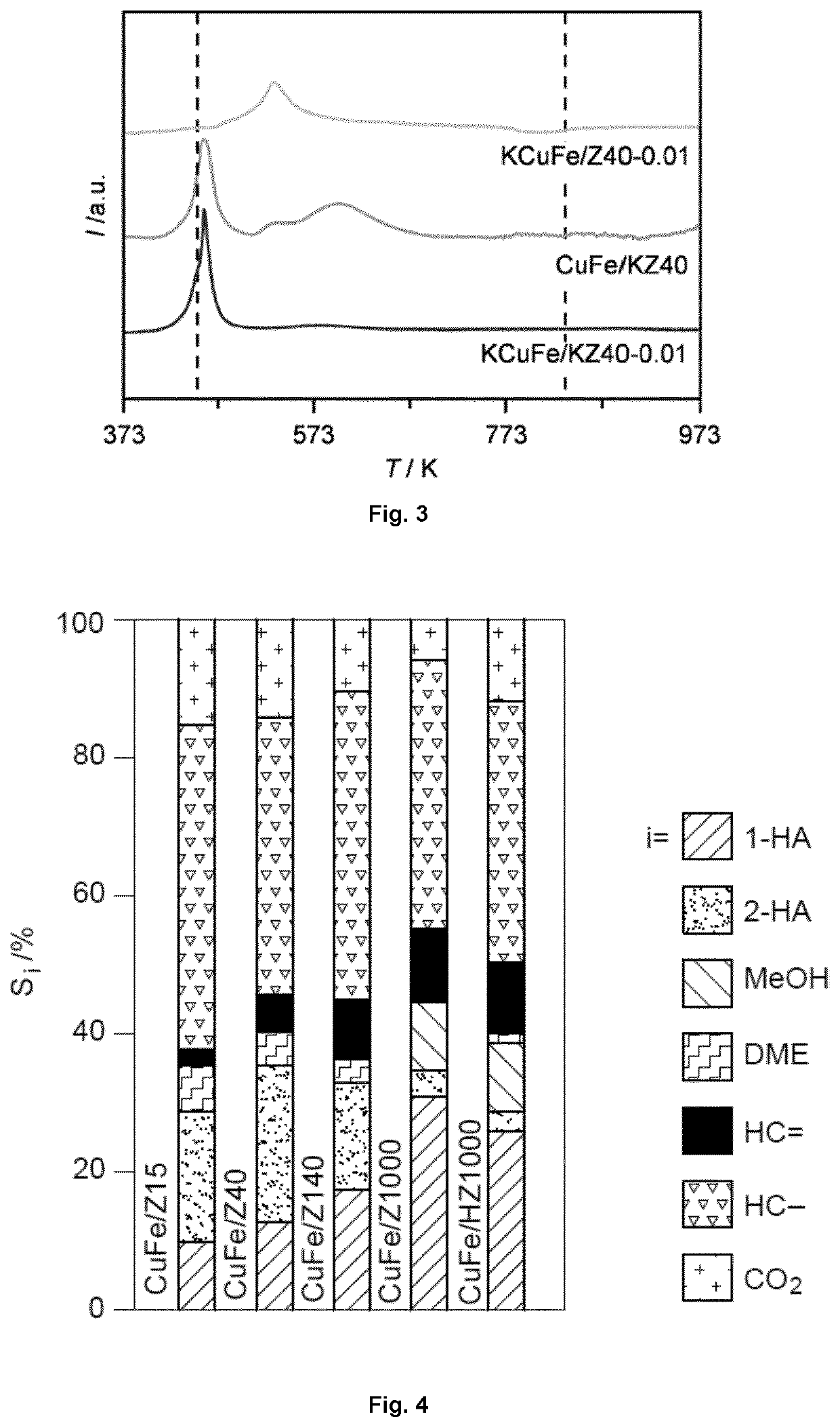Copper-Iron-Based Catalytic Composition Comprising Zeolites, Method for Producing Such Catalytic Composition and Process Using Such Catalytic Composition for the Conversion of Syngas to Higher Alcohols
a catalytic composition and copper iron technology, applied in the direction of physical/chemical process catalysts, calcination, bulk chemical production, etc., can solve the problems of no catalytic system reported that has performed sufficiently well to justify industrial implementation, and achieves the effect of improving co conversion to higher alcohols and high catalyst stability
- Summary
- Abstract
- Description
- Claims
- Application Information
AI Technical Summary
Benefits of technology
Problems solved by technology
Method used
Image
Examples
example 1
on of the MFI Zeolite Supports
[0217]Various MFI zeolites were used as supports for CuFe catalysts. Silicalite with a Si / Al molar ratio of 1060 was purchased in protonic form (Tosoh Corporation, HSZ-890 / HOA, denoted as Z1000) and was used as received. Hierarchical silicalite (denoted as HZ1000) was prepared by treating Z1000 in aqueous NaOH (Merck-Schuchardt, 99%, 0.2 M, 338 K (64.85° C.), 33.3 gzeolite dm−3, 30 min) using an Easymax™ 102 (Mettler Toledo), followed by quenching in an ice-water mixture. The solid was recovered by filtration, washed extensively with water, dried at 338 K (64.85° C.) overnight, and converted into the protonic form by ion exchange in aqueous NH4NO3 (Acros Organics, >99%, 0.1 M, 298 K (24.85° C.), 10 zeolite dm−3, 8 h, 3 cycles), followed by calcination in static air at 823 K (549.85° C.) (ramp rate=5 K min−1) for 5 h. MFI zeolites with nominal Si / Al molar ratios of 15, 40, and 140 (Zeolyst Ltd., denoted as Zx, where x is the Si / Al molar ratio) were deliv...
example 2
n of the Bimetallic CuFe Catalyst on the MFI Zeolite Supports
[0218]Supported CuFe catalysts with a Cu / Fe bulk molar ratio of 2 and CuFe loading of 5 wt. % were prepared by dry impregnation.
[0219]The copper precursor was Cu(NO3)2.3H2O, and the iron precursor was Fe(NO3)3.9H2O.
[0220]Cu(NO3)2.3H2O (0.278 g, Aldrich Fine Chemicals, 98-103%) and Fe(NO3)3.9H2O (0.232 g, Aldrich Fine Chemicals, >98%) were dissolved in an amount of deionized water equal to the pore volume of the support and added drop-wise to the support (2.00 g, except KZ40p) under magnetic stirring. The resulting solid was kept under stirring for 30 min, dried in air at 338 K (64.85° C.) overnight, calcined in air at 573 K (299.85° C.) (3 K min−1) for 3 h, and reduced in a 10 vol % H2 / He flow of 20 cm3 STP min−1 at 673 K (399.85° C.) (3 K min−1) for 4 h. These catalysts were denoted as CuFe / (K)Zx.
[0221]The MFI zeolite support when supporting the bimetallic catalyst CuFe advantageously presents a mesoporous surface area th...
example 3
n of Supported FeCu Catalysts Promoted with Potassium
[0225]Potassium can be added to the catalyst composition by adding a potassium precursor (e.g., K2CO3) to the solution of copper and iron precursors, prior to the dry impregnation onto the MFI zeolite support. More specifically, potassium was deposited onto Z1000 and Z40 simultaneously to Cu and Fe upon dry impregnation.
[0226]Alternatively, potassium can be added to the catalyst composition by ion-exchange of the MFI zeolite support. Thus, Z40 was ion-exchanged with potassium to generate a solid (KZ40), which was then impregnated with the copper and iron precursors, or with copper, iron and potassium precursors.
[0227]To produce K-promoted CuFe catalysts supported on Z1000, Z40, and KZ40, K2CO3 (0.59-5.9 mg, Aldrich Fine Chemicals, 98-103%) was added to the Cu- and Fe-containing solution prior to the impregnation. Bulk molar K / (Cu+Fe) ratios of 0.01 were targeted for all catalysts, while ratios of 0.005 and 0.05 were additionally c...
PUM
| Property | Measurement | Unit |
|---|---|---|
| molar ratio | aaaaa | aaaaa |
| molar ratio | aaaaa | aaaaa |
| particle size | aaaaa | aaaaa |
Abstract
Description
Claims
Application Information
 Login to View More
Login to View More - R&D
- Intellectual Property
- Life Sciences
- Materials
- Tech Scout
- Unparalleled Data Quality
- Higher Quality Content
- 60% Fewer Hallucinations
Browse by: Latest US Patents, China's latest patents, Technical Efficacy Thesaurus, Application Domain, Technology Topic, Popular Technical Reports.
© 2025 PatSnap. All rights reserved.Legal|Privacy policy|Modern Slavery Act Transparency Statement|Sitemap|About US| Contact US: help@patsnap.com



